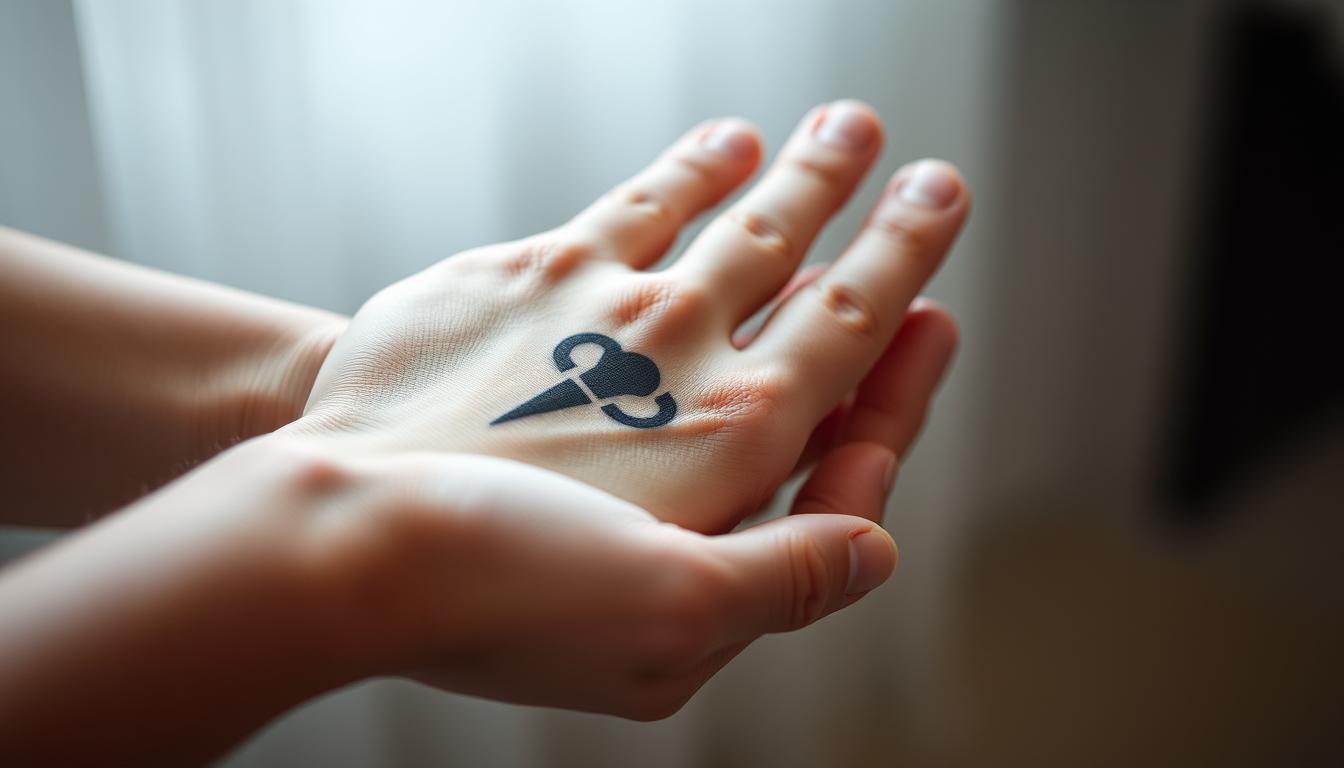
What if everything you’ve heard about tattoo discomfort is only half the story? While needles and skin might seem like an obvious recipe for ouch, the reality of body art isn’t as simple as “yes, it hurts.” Your experience depends on factors you can actually control—if you know how.
Modern tattooing uses precise tools to deposit ink into the skin’s dermis layer. This process creates a sensation often described as a mix of scratching and vibration. But here’s the twist: your ribcage and fingertips won’t feel the same. Body placement plays a huge role in what you’ll feel.
Your biology also matters. Some people’s nervous systems handle repetitive stimuli better than others. Hydration, stress levels, and even the time of day can influence your perception of discomfort. The good news? Techniques like numbing creams and breathing exercises help many sit through sessions comfortably.
Key Takeaways
- Pain levels vary based on body location and personal tolerance
- Proper preparation can significantly reduce discomfort
- Modern techniques make the process more manageable than ever
- Aftercare impacts both healing and long-term satisfaction
- Open communication with your artist improves the experience
Understanding Tattoo Pain and Its Sensations
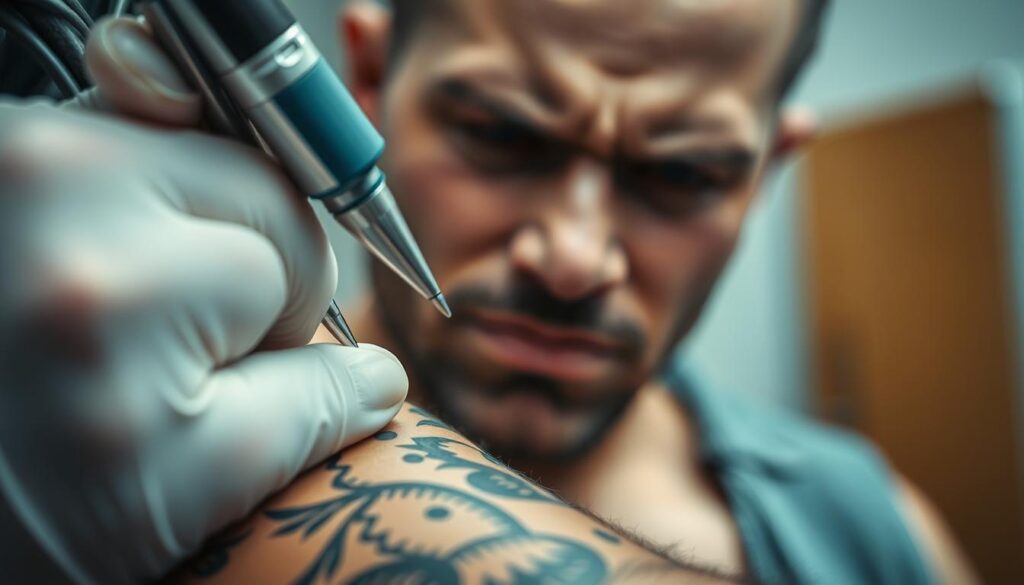
Getting inked involves a mix of sensations that shift as the needle moves. Your body reacts uniquely depending on placement, technique, and how your nerves respond. Think of it like a playlist – different tracks play as the artist works through shading, outlines, or filling.
What to Expect During a Tattoo Session
Most people notice a background ache first. Your body releases adrenaline, which helps dull the initial sting. Areas with more muscle or fat tend to feel like persistent pressure, while bony spots (like collarbones) create a buzzing vibration.
Types of Pain Sensations Explained
Scratching pain often happens during shading. Multiple needles drag across your skin, similar to light cat scratches. For fine lines, single needles create quick, sharp pricks – think of a sewing machine tapping your arm.
Longer sessions might bring a warm, burning feeling. This builds gradually, like holding your hand near a heater. Artists often take breaks if this becomes intense. Remember: these sensations are temporary and part of creating lasting art.
Anatomy of Tattoo Pain: Nerve Endings, Skin, and More
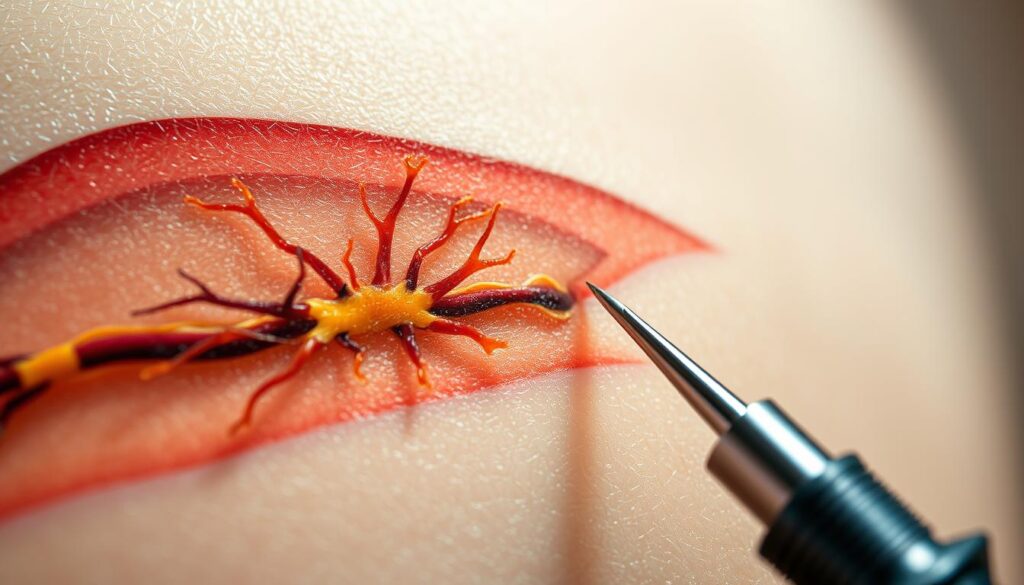
Your skin isn’t just a passive canvas—it’s a living alarm system. When needles pierce through its layers at 100 punctures per second, your body triggers multiple defense mechanisms. This biological dance between art and anatomy determines what you’ll feel during the process.
How Your Skin Reacts to Needles
Tattoo needles target the dermis, the skin layer housing collagen and sweat glands. Unlike surface scratches, this deeper penetration activates specialized cells called nociceptors. These pain receptors flood your brain with signals ranging from mild irritation to sharp alerts.
Your body responds instantly. Blood vessels dilate, causing localized swelling. Damaged cells release histamines, creating that familiar warm, stinging sensation. Thinner skin areas—like wrists or ankles—amplify these reactions because needles reach nerve clusters faster.
The Role of Nerve Endings in Pain Perception
Nerve density varies dramatically across your body. Areas like your ribs or fingers contain up to 200 nerve endings per square centimeter. Compare that to your calves, which might have just 20. More nerves mean more frequent pain signals firing to your brain.
Your skin’s thickness acts as a natural pain regulator. Fatty regions cushion needle impacts, while bony zones offer no buffer. Artists often adjust their technique based on these biological factors—using slower passes over sensitive zones to minimize discomfort.
Factors That Influence How Painful a Tattoo Can Be
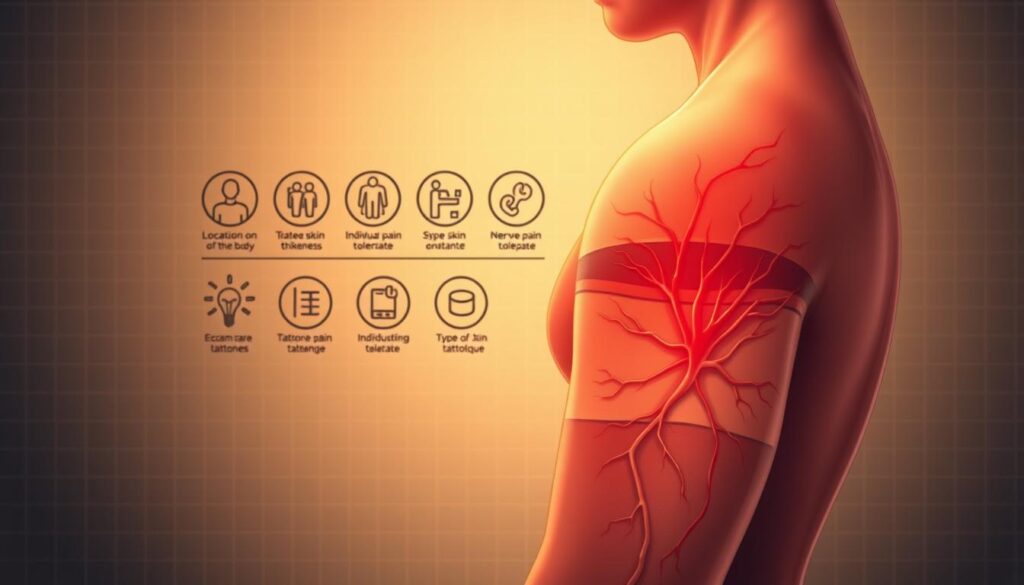
Your body’s blueprint determines more than just your appearance—it shapes your entire tattoo experience. Three key elements work together: where you place the art, how ambitious your design is, and your unique biological makeup. Let’s break down what really moves the needle on discomfort levels.
Impact of Body Geography and Cushioning
Think of your skin as a topographic map. High-elevation zones with bony landmarks (ribs, ankles) amplify sensations, while valleys with more padding (thighs, upper arms) soften the blow. Fat acts like nature’s shock absorber here:
- Outer thighs and calves: 5/10 pain scale
- Ribcage and collarbones: 8/10 pain scale
Areas with dense nerve clusters—like fingers or spine—send stronger signals to your brain. Thicker skin on the chest or back creates a buffer, making these body parts surprisingly manageable for first-timers.
When Bigger Isn’t Always Better
A palm-sized design might take 90 minutes, while a full sleeve requires multiple 4-hour sessions. Longer exposure to needles increases fatigue, which can heighten pain perception over time. Consider these factors when planning:
- Simple linework vs. detailed shading
- Single-needle precision vs. multi-needle coverage
- Artist speed and pressure adjustments
Pro tip: Schedule morning sessions when adrenaline levels are highest. Eat a protein-rich meal beforehand—low blood sugar magnifies discomfort. Your artist can suggest size adjustments to balance aesthetics with comfort.
A Closer Look at Personal Pain Tolerance and Experience

Your body’s response to ink isn’t just about needles—it’s a complex conversation between biology and mindset. While artists use the same tools for everyone, your pain threshold acts like a personalized volume knob for discomfort.
Why Your Pain Threshold Matters
Studies reveal an intriguing pattern: those with previous body art often handle pressure better than first-timers. Your first tattoo might feel like a surprise exam, while subsequent sessions become predictable pop quizzes. This isn’t just physical adaptation—it’s psychological familiarity.
| Factor | Impact on Experience | Management Tip |
|---|---|---|
| Age | Thinner skin = heightened sensitivity | Choose fleshy areas |
| Mental State | Anxiety amplifies sensations | Practice box breathing |
| Hydration | Plump cells cushion needles | Drink 16oz water pre-session |
Real-Life Experiences and Varying Sensitivities
Consider Sarah and Mia—identical rose designs on their shoulders. Sarah described it as “warm cat scratches,” while Mia felt “persistent bee stings.” Both experiences are valid because nerve density varies by up to 40% between people.
Hormonal cycles and hydration levels create daily differences too. A dehydrated morning session might feel sharper than an afternoon appointment after proper fueling. Remember: your journey is unique—comparisons only create unnecessary stress.
Tips to Manage and Minimize Tattoo Pain
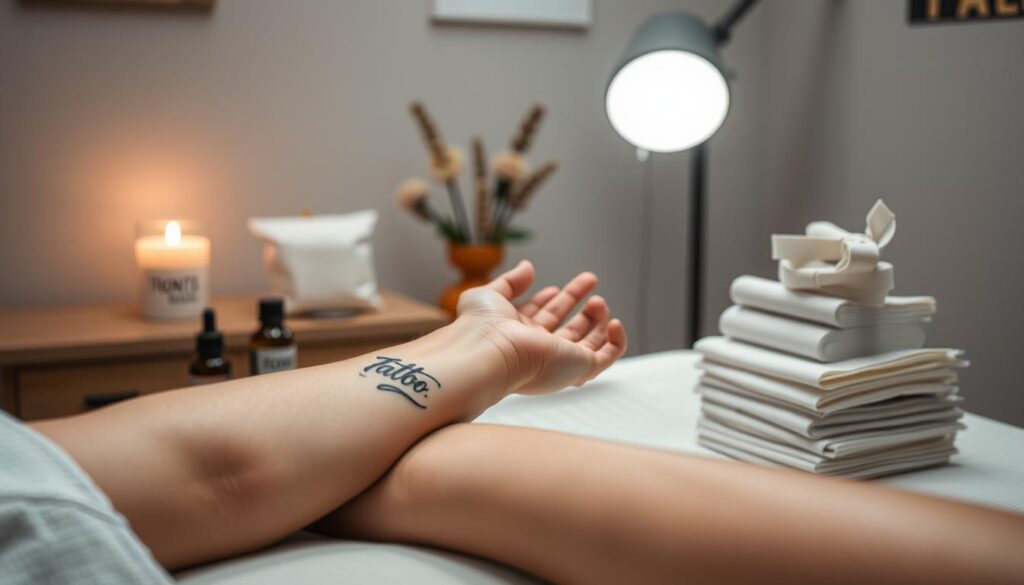
Taking control starts with knowing your options. Modern solutions and smart prep work can transform what many assume will be grueling into something surprisingly manageable. Let’s explore proven methods that help you stay comfortable while getting inked.
Numbing Solutions That Actually Work
Topical creams with 5% lidocaine create a protective barrier between your nerves and the needle. Apply a pea-sized amount 90 minutes before your session—cover it with plastic wrap to boost absorption. This temporary “mute button” typically lasts through outline work and basic shading.
“Proper prep turns a daunting session into a manageable process,” advises Mia, a NYC-based tattoo artist.
Fueling Your Body for Success
Your skin behaves differently when hydrated. Drink water like you’re training for a marathon—aim for 8 glasses daily starting three days pre-appointment. Avoid coffee and cocktails; they thin blood and heighten sensitivity. Eat a protein-rich meal 2 hours beforehand to stabilize energy levels.
Bring distractions that engage other senses. Noise-canceling headphones with upbeat playlists help many clients. Others find stress balls or fidget toys useful for redirecting focus during intense moments. Your artist can suggest position adjustments if certain spots feel tender.
First-timers often benefit from shorter sessions. A 2-hour commitment lets you test strategies before tackling larger pieces. Remember: communication is key. Speak up about comfort levels—artists want you happy with both the process and results.
Do Tattoos Hurt? Breaking Down the Myths and Facts
Let’s cut through the noise surrounding ink sessions. While some wear their discomfort like a badge of honor, modern body art prioritizes smart strategies over unnecessary grit. Your experience matters more than outdated stereotypes.
Truth vs. Fiction in Body Art
The idea that painful tattoo experiences create “better” results is pure fiction. Research shows no correlation between discomfort levels and artwork quality. Those who claim you must “earn” your design through suffering ignore today’s proven comfort tools.
| Myth | Reality | Smart Solution |
|---|---|---|
| Pain proves commitment | Comfort enhances focus | Use numbing creams |
| Gender determines tolerance | Biology varies individually | Choose padded areas |
| Breaks ruin the process | Pauses prevent fatigue | Schedule short sessions |
“Your endurance doesn’t make the ink more permanent,” notes NYC artist Mia.
Science backs this: studies suggest women might feel sharper sensations, but personal nerve density matters most.
You control three key factors: placement, preparation, and mindset. Opt for meatier areas like thighs if sensitivity concerns you. Hydrate thoroughly—plump skin cells cushion needles better. Distract your brain with podcasts or playlists during longer sessions.
Remember: your body art journey shouldn’t feel like a test. Quality artists want you comfortable, not clenched. Speak up about breaks or adjustments—your comfort shapes both the process and final masterpiece.
Aftercare and Recovery: Dealing With Post-Tattoo Pain
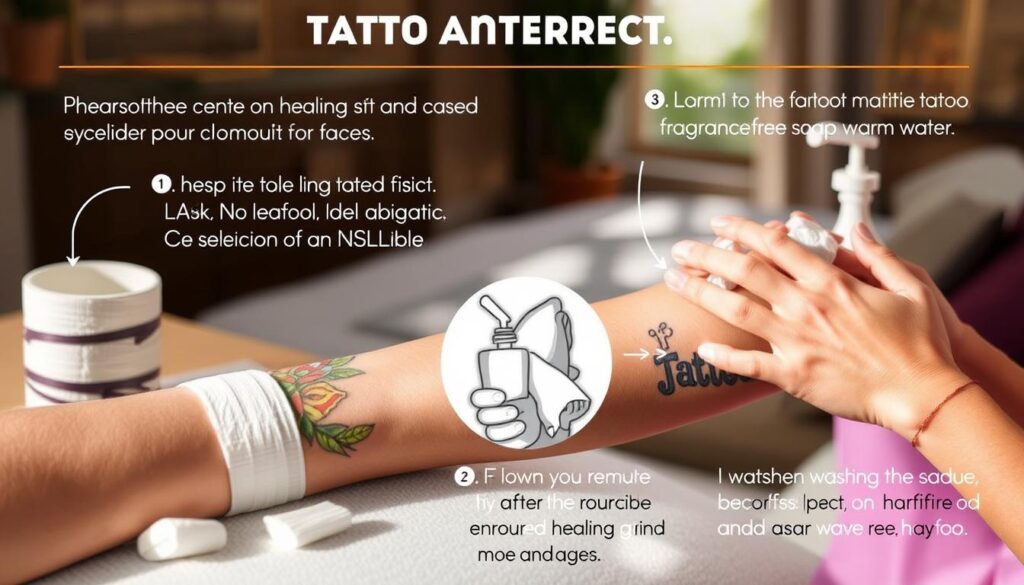
Healing is where art meets science in your tattoo’s story. Fresh ink creates a temporary wound—your skin needs strategic care to transform tenderness into vibrant results. Expect mild swelling and warmth for 3-5 days as your body repairs the treasured trauma.
Smart Healing Habits Make All the Difference
Start with a clean slate: wash the area gently 2-3 times daily using fragrance-free soap. Pat dry—never rub—then apply a thin layer of ointment. “Think of aftercare as protecting an investment,” advises artist Mia.
Avoid tight clothes that stick to your design during early healing phases.
Resist the itch! Days 4-7 often bring maddening sensations as new skin forms. Slap the spot lightly instead of scratching. Keep it shaded—UV rays fade colors and irritate delicate tissue. Hydrate like it’s your job; plump cells heal faster.
Reading Your Body’s Signals
Normal healing includes:
- Pinkish redness fading daily
- Mild soreness resembling a sunburn
- Flaking like a subtle glitter shower
Sound the alarm if you see:
- Yellow pus or spreading redness
- Throbbing that disrupts sleep
- Fever above 100.4°F
Over-the-counter meds ease initial pain, but always follow your artist’s plan. Most soreness lifts within a week—if discomfort spikes instead of dips, reach out. Your aftercare choices today shape tomorrow’s masterpiece.
Conclusion
Your tattoo journey reflects both science and self-expression. While body parts like ribs or hands might challenge your nerve tolerance, smart planning transforms the experience. Choose fleshy areas for your first tattoo—they’re often less painful and let you build confidence.
Work with your artist to optimize design placement. A skilled professional adjusts needle pressure and session length based on your feedback. Remember: temporary sensation creates permanent art worth celebrating.
Preparation matters more than you think. Hydrated skin cushions better, while distractions like music help refocus your mind. Aftercare isn’t optional—proper healing ensures your new tattoo stays vibrant with minimal discomfort.
Every body tells its own story through ink. What feels like a bee sting to one person might resemble cat scratches to another. Trust your instincts, communicate openly, and embrace this creative partnership. Your skin’s masterpiece awaits.
